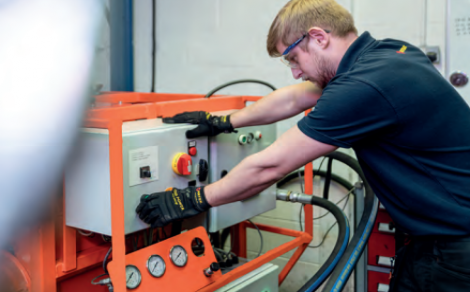- Home » Editorial » Hydraulics
What is hydraulic hose flushing?

Hydraulic hose flushing is a process of removing any construction debris or particles from within the inner tube of a hose in order to completely cleanse the system and flush through any present contamination that could lead to damage and/or operational issues. Ian Cochran, National Technical Support Manager, Pirtek UK and Ireland, explains further
During the hose flushing process, high velocity fluid is forcibly passed through the hose, the pressure of which will dislodge any debris that’s managed to infiltrate the hose, either during its manufacture, while sitting in storage, or whilst in transportation to site. Hose flushing rids the hose of any such contaminants, thereby protecting the integrity of the hose and the health of hydraulic machinery.
When should you flush a hydraulics hose?
Flushing a new hose assembly ensures that any contamination with the potential to endanger the performance of hydraulic machinery is dispersed and removed. Hydraulic powered systems are extremely sensitive to variance, and even the smallest amount of debris left unchecked could result in a system breakdown that takes your business offline and causes costly downtime.
Hose flushing effectively ensures a hose achieves the same levels of cleanliness as the hydraulic fluid running through it, and allows you to minimise and control future contamination (generated during operation) by filtration alone.
On-site hose cleaning
What if a custom hose assembly is made on site by a technician on a van, without access to a flushing rig? In that case, the most efficient and, therefore, most popular way of doing this is by blowing a foam cleaning projectile through the hose using a special pneumatic air gun connected to a compressed air unit. This technique is referred to as hydraulic hose projectile cleaning.
The manufacturers of these cleaning systems claim that hose cleanliness levels as good as ISO 4406 13/10 are achievable. But the results achieved depend on a number of variables, which include using a projectile of the correct diameter for the hose being cleaned, whether the projectile is used dry or wetted with solvent, and the number of shots fired. Generally, the higher the number of shots, the cleaner the hose assembly. Furthermore, if it is a new hose that’s being cleaned, the projectile cleaning should be done before the ends are crimped on.
Is hydraulic hose flushing a standard part of the manufacturing process of hose assemblies?
Hydraulic hose flushing plays an important role in keeping hydraulic systems moving and reducing the risk of a hydraulic hose breakdown.
This is because the hydraulic fluid passing through a hose naturally degrades over time, and when this occurs it results in sludge, varnish and other microbes contaminating the system. A non-urgent hose flushing service, at a time that doesn’t impact your business, is the most effective way to tackle hydraulic fluid degradation.
-
SMART Manufacturing & Engineering Week
04 - 05 June, 2025
NEC, Birmingham UK -
PPMA 2025
23 September, 2025, 9:30 - 25 September, 2025, 16:00
NEC, Birmingham UK -
Advanced Engineering Show 2025
29 October, 2025, 9:00 - 30 October, 2025, 16:00
NEC, Birmingham UK










